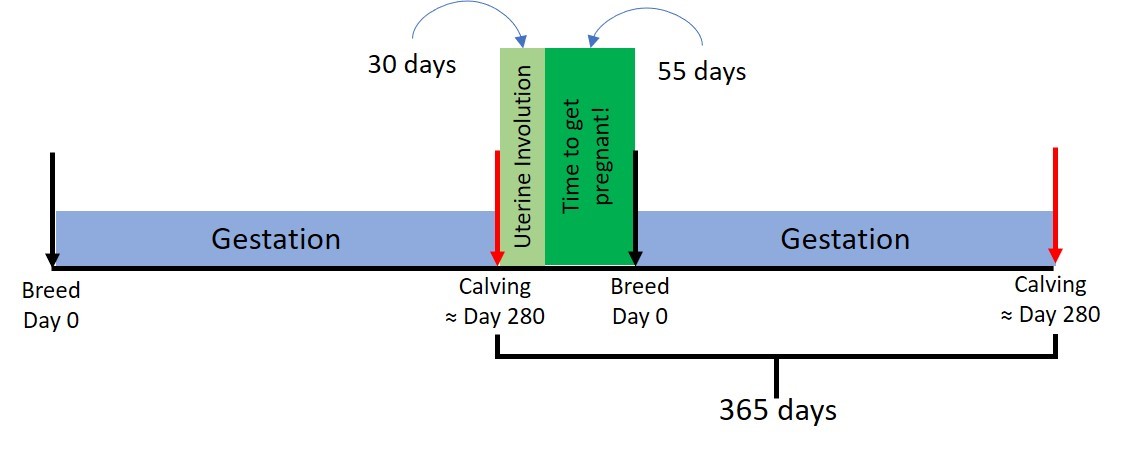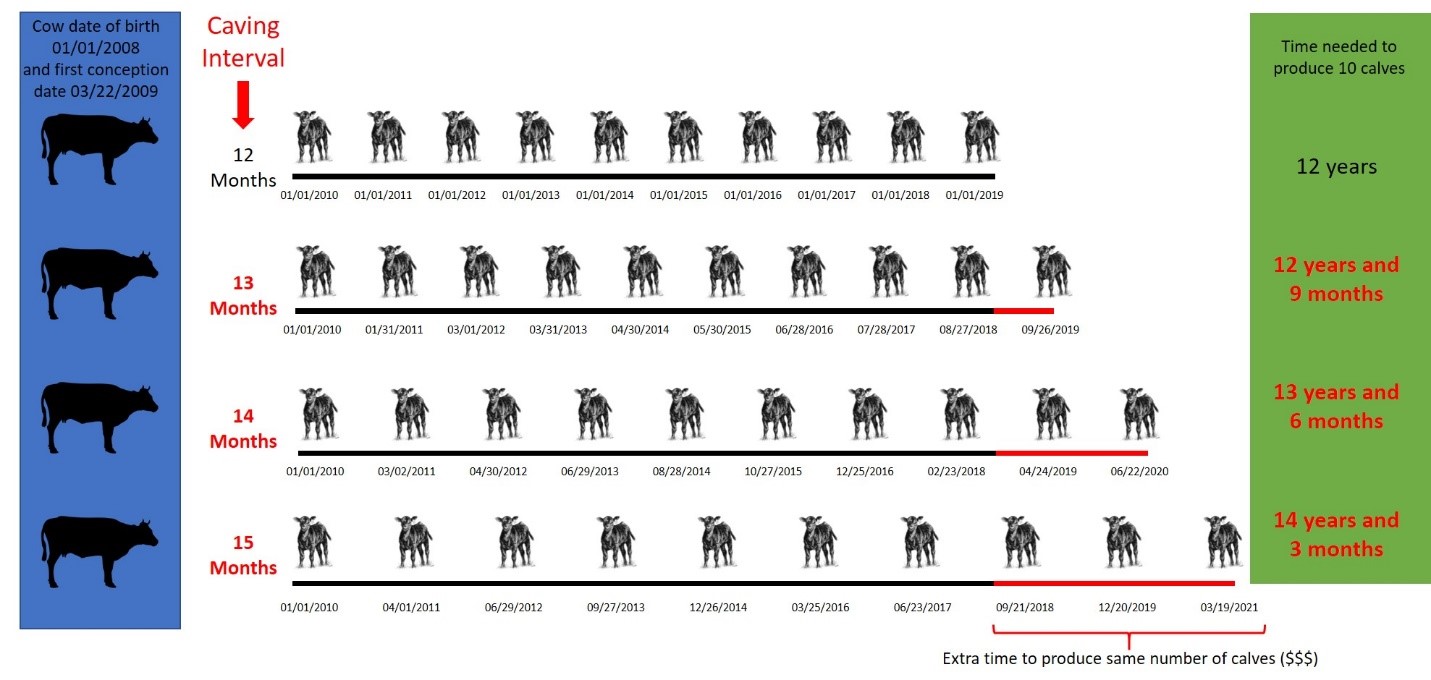Angela Gonella-Diaza, UF/IFAS Beef Cattle Reproduction Specialist, NFREC Marianna
The profitability of the cow-calf operation is directly related to herd reproductive efficiency. The efficient cow is the one that calves every year at about the same time. As is shown in graph below, to calve every 12 months, a cow must be bred and became pregnant within 85 days post-calving (280-day gestation + 85 days = 365 days). However, after calving, the cow requires 30 to 45 days for uterine involution and post-partum recovery. This means that, if everything is right (no diseases, good body condition score, no calving problems), the cow only has 55 days to get pregnant to calve on an annual basis, which should be your goal!

Figure 1: The calving interval period of a beef cow in an annual breeding program. At day 0 the cow became pregnant, and after approximately 280 days of pregnancy she gave birth to a calf. After calving, the cow requires 30-45 days to recover (uterine involution) and prepare for breeding. After recovery, she must become pregnant in less than 55 days to achieve a 12-month calving interval.
This is not an easy task! Every cow-calf operation is different, but there are several reproductive programs available: natural breeding, timed natural breeding, artificial insemination, timed artificial insemination, embryo transfer, etc. Ideally, all of these take place during a set breeding season, but could take place throughout the year. Regardless of the reproductive program you choose, you should always evaluate reproductive efficiency. You may ask, why is it so important to assess the reproductive efficiency of your cows? Let’s use an example to answer this question.
Let’s imagine that in a herd without a controlled breeding season (i.e., bulls in with the cows through the year) you have 4 different cows; they are all similar (date of birth: 01/01/2008; puberty achieved at 12 months and became pregnant at 03/22/2009) except for one thing: the calving interval period. As you can see in the graph below, cow number one has a 12-month calving interval, which is ideal! This means that during her life, she raises a calf each year, and after 12 years of life, she produces 10 calves. Cow number two has a 13-month of calving interval, and she also produces 10 calves during her life. However, she took 12 years and 9 months to deliver her 10 calves. Cow number 3 has a 14-month calving interval and took 13 years and 6 months to produce 10 calves. Finally, cow number four, has a calving interval of 15 months, took 14 years and 3 months to produce the same 10 calves.
Imagine the increased expenses for cow #4? How much more would it costs feed this cow for an additional 2 years and 3 months to produce the same 10 calves? This is why it is imperative to evaluate the reproductive efficiency of the herd, and promptly cull animals with low reproductive efficiency.
For cow-calf operations, establishment of a defined breeding season allows the concentration of conception, thus facilitating the general management of beef herds. This is because, unlike farms where the breeding occurs throughout the year, farms with an established breeding season concentrate calving in only a few months of the year. This may not seem that important, but it provides significant benefits for efficient management of both costs and labor.
In my opinion, one of the most important aspects of having a breeding season for your operation is that you can quickly identify which cows to cull. When you have a specific period of the year when your calves are born, you can easily calculate the number of calves produced each year and also which cows were not bred. Also, if you utilize pregnancy diagnosis (rectal palpation, ultrasound [Figure 3] or blood test) you can identify the cows that remain open after the breeding season, and cull them immediately or after weaning, so you won’t need to wait until after the calving season.

Figure 3: Ultrasound images of pregnancy diagnosis in beef cattle. Left and center images are gray-scale ultrasound images of a 30-day and 60-day fetuses. Right is a Doppler ultrasound image of the corpus luteum, used to make an early pregnancy diagnosis (20 days after AI).
Also, cows that become pregnant in the first two months of the breeding season are the most productive and desired females, because they have additional post-partum recovery time before the next breeding season, thereby improving the probability of re-establishing pregnancy. Also, because these females give birth in a more favorable season of the year, their calves are healthier and have higher weaning weights. The heifer calves born early in the season are more likely to integrate into the established breeding season of the herd (Figure 4).

Figure 4: Having a well-established breeding season helps identify the best cows to keep to improve reproductive efficiency. From left to right: photos A and B were taken in the “Agropecuaria Las Tinajas” in Puerto Berrio, Colombia (South America). Commercial Brahman cows were timed artificially inseminated (TAI) using Angus semen. Picture C was a commercial cow and calf at the UF/IFAS North Florida Research and Education Center, Marianna. The calf was born during the calving season (December of 2018 to February of 2019), and the cow was bred using TAI on March 23, 2019, and was 90 days into gestation in this photo. Picture D was taken at Southern Accent Ranch near Okeechobee, Florida, owned by Allen and Nicki Smith. The picture shows a group of high quality, uniform calves that were recently weaned. Their reproductive program consisted of estrous synchronization plus AI after heat detection, with re-synchronization and a second AI 28 days after the first one. They have successfully used this program for the past 10 years.
–
Take home message
- It is very important to evaluate the reproductive efficiency of your herd. Cows with low reproductive efficiency require more time and money to produce a desirable number of calves. Having a well-established breeding season helps to quickly identify the best cows to keep, and the cows with lower reproductive efficiency to cull.
- Managing cows to breed and calve in a short and defined season can be accomplished with advanced planning and coordination. Established breeding seasons make nutritional management more efficient and less costly. Culling cows with lower reproductive efficiency allows other management practices to be applied more easily (pregnancy checking, vaccinations, single weaning date, improved marketing options, etc. The end result is a more profitable cow-calf operation.
- If you are interested in moving from a year-round breeding program to a defined breeding season, you can do it slowly and progressively over a 2-3 year period. If you require more information, do not hesitate to contact me or your county extension agent. We can advise you on the best course of action to fit your operation.
- Bull Management for Effective Breeding Performance in Cow-Calf Operations - September 19, 2025
- Heat Stress and its Impact on Cattle Reproduction - March 14, 2025
- Fall is Here.Time for Pregnancy Testing Cattle! - September 13, 2024

